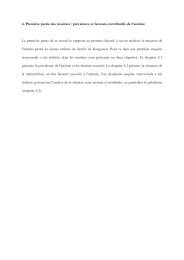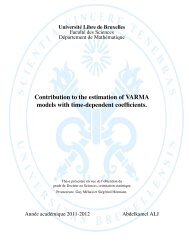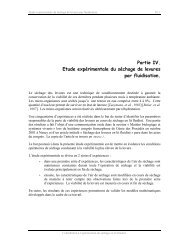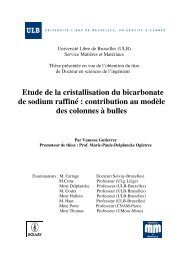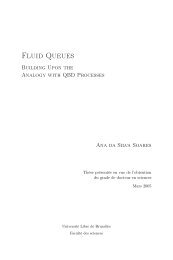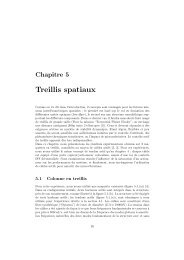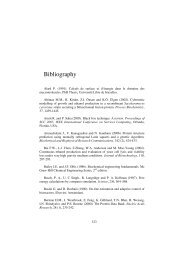Diapositive 1 - de l'Université libre de Bruxelles
Diapositive 1 - de l'Université libre de Bruxelles
Diapositive 1 - de l'Université libre de Bruxelles
You also want an ePaper? Increase the reach of your titles
YUMPU automatically turns print PDFs into web optimized ePapers that Google loves.
Chapitre IVratioed against background to minimize CO 2 and H 2 O bands. To assess reproducibility,several spectra from the same sample were obtained and the results gave correlationcoefficients higher than 95%.X-ray absorption near-edge structure spectroscopy (XANES)X-ray absorption near-edge structure spectroscopy is performed by tuning the energy ofan X-ray beam around an absorption edge of an element of interest. At the sulphur K-edge, the position of the white line has been <strong>de</strong>monstrated to vary significantly withoxidation state, and this shift is very useful for assessing sulphur speciation. In particular,thiols, disulfi<strong>de</strong>s and sulphates spectra exhibit characteristic feature differences.This study was carried out at the X-ray Microscopy Beamline ID21 of the EuropeanSynchrotron Radiation Facility (ESRF), Grenoble, France. The X-ray beam energy wastuned around the sulphur K-edge (2472 eV) using a fixed exit double crystal Si(111)monochromator, providing an energy resolution of DE/E=10 -4 necessary to resolve theXANES features. In the Scanning X-ray Microscope (SXM), a germanium Fresnel zoneplate optimized for this energy range was used to focus the beam to a submicronmicroprobe. The photon flux in the X-ray microprobe within the bandwidth of the doublecrystal Si(111) monochromator was 4 × 10 8 photons s -1 . A high purity Ge energydispersive <strong>de</strong>tector (Princeton Gamma-Tech, NJ) mounted in the horizontal planeperpendicular to the beam was used to collect the fluorescence photons emitted from thesample. The monitoring of the incoming beam intensity on the sample, which is essentialto correct the acquired XANES spectra and images for beam intensity fluctuations, wasensured using a drilled photo-dio<strong>de</strong> collecting the fluorescence from a 0.75 μm thick Alfoil inserted in the beam path. The SXM was operated un<strong>de</strong>r vacuum to avoid the strongabsorption of the sulphur emission lines by air.Reference spectra of standard compounds (S containing amino acids, chondroitin sulfate)were acquired for energy calibration in unfocussed mo<strong>de</strong> (i.e., without the zone plate butwith a 200 μm aperture <strong>de</strong>fining the beam size). For these concentrated standards, theHpGe <strong>de</strong>tector was replaced by a Si photodio<strong>de</strong> for the fluorescence signal measurements.Standards were finely groun<strong>de</strong>d and <strong>de</strong>posited between two ultralene foils. Energy scansbetween 2450 eV and 2540 eV were performed with 0.225 eV increments. Lyophilizedsoluble and insoluble organic matrices extracted from the skeleton of A. rubens wereanalyzed using the same conditions.82



